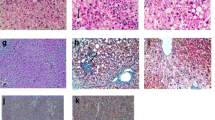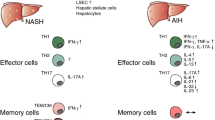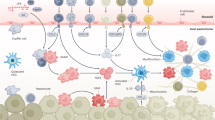Abstract
Background
The interaction between T-cells/fatty acids involved in non-alcoholic fatty liver disease (NAFLD) and liver fibrosis progression is poorly understood. In this study, we conducted a comprehensive analysis of T-cell profiles of NAFLD patients to better understand their relationship with fatty acids and relevance to liver fibrosis.
Methods
We analyzed the differences in T-cell profiles of peripheral blood mononuclear cells (PBMCs) between 40 NAFLD patients and 5 healthy volunteers (HVs), and their relationship with liver fibrosis stage or progression. Moreover, we analyzed the relationship between T-cell profiles and fatty acid compositions in vivo, and changes in T-cell profiles after treatment with fatty acids in vitro.
Results
T-cell profiles of NAFLD patients were different from those of HVs. The CD25+CD45+CD4+ T-cell frequency was increased in NAFLD patients with high liver fibrosis stage and progression, and this indicated immune activation. Despite such a state of immune activation, the PD1+CD4+ T-cell frequency was decreased in the same patients group. The PD1+CD4+ T-cell frequency had a significantly negative correlation with the serum fatty acid composition ratio C16:1n7/C16:0. Moreover, the PD1+CD4+ T-cell frequency was significantly decreased by in vitro treatment with fatty acids. In addition, its rate of frequency change was significantly different between C16:0 and C16:1n7 and decreased by artificially increasing the C16:1n7/C16:0 ratio.
Conclusions
The analysis of PBMCs in NAFLD patients showed that T-cell profiles were different from those of HVs. And, it suggested that fatty acids modified T-cell profiles and were involved in liver fibrosis in NAFLD patients.






Similar content being viewed by others
Abbreviations
- NAFLD:
-
Non-alcoholic fatty liver disease
- NASH:
-
Non-alcoholic steatohepatitis
- CD:
-
Cluster of differentiation
- PBMCs:
-
Peripheral blood mononuclear cells
- NAS:
-
NAFLD activity score
- RPMI:
-
Roswell Park Memorial Institute
- FSC:
-
Fetal calf serum
- Treg :
-
Regulatory T-cell
- FoxP3:
-
Forkhead box P3
- T-bet:
-
T-box expressed in T-cells
- RORγt:
-
Retinoic acid-related orphan receptor gamma t
- Th:
-
T-helper
- CTLA-4:
-
Cytotoxic T-lymphocyte-associated protein 4
- PD-1:
-
Programmed death 1
- CXCR3:
-
C-X-C motif chemokine receptor 3
- CCR4:
-
C–C motif chemokine receptor 4
- IHC:
-
Immunohistochemistry
- DAPI:
-
4′6-Diamidino-2-phenylindole
- NAFL:
-
Non-alcoholic fatty liver
References
Loomba R, Sanyal AJ. The global NAFLD epidemic. Nat Rev Gastroenterol Hepatol. 2013;10:686–90.
Chalasani N, Younossi Z, Lavine JE, et al. The diagnosis and management of nonalcoholic fatty liver disease: practice guidance from American Association for the Study of Liver Disease. Hepatology. 2018;67:328–57.
Racanelli V, Rehermann B. The liver as an immunological organ. Hepatology. 2006;43:S54–S64.
Henning JR, Graffero CS, Rehman A, et al. Dendritic cells limit fibroinflammatory injury in nonalcoholic steatohepatitis in mice. Hepatology. 2013;58:589–602.
Ma C, Kesarwala AH, Eggert T, et al. NAFLD causes selective CD4(+) T lymphocyte loss and promotes hepatocarcinogenesis. Nature. 2016;531:253–7.
Sutti S, Jindal A, Locatelli I, et al. Adaptive immune responses triggered by oxidative stress contribute to hepatic inflammation in NASH. Hepatology. 2014;59:886–97.
Yamada K, Mizukoshi E, Sunagozaka H, et al. Characteristic of hepatic fatty acid compositions in patients with nonalcoholic steatohepatitis. Liver Int. 2015;35:582–90.
Cusi K. Role of obesity and lipotoxicity in the development of nonalcoholic steatohepatitis: pathophysiology and clinical implication. Gastroenterology. 2012;142:711–25.
Akazawa Y, Nakao K. To die or not to die: death signaling in nonalcoholic fatty liver disease. J Gastroenterol. 2018;53:893–906.
Cazanave SC, Mott JL, Bronk SF, et al. Death receptor 5 signaling promotes hepatocytes lipoapoptosis. J Biol Chem. 2011;286:39336–48.
de Jong AJ, Kloppenburg M, Toes RE, et al. Fatty acids, lipid mediators, and T-cell function. Front Immunol. 2014;13:483.
Howie D, Ten Bokum A, Necula AS, et al. The role of lipid metabolism in T lymphocyte differentiation and survival. Front Immunol. 2018;8:1949.
Lochner M, Berod L, Sparwasser T. Fatty acid metabolism in the regulation of T cell function. Trends Immunol. 2015;36:81–91.
Kleiner DE, Brunt EM, Van Natta M, et al. Design and validation of a histological scoring system for nonalcoholic fatty liver disease. Hepatology. 2005;41:1313–21.
Mizukoshi E, Nakamoto Y, Marukawa Y, et al. Cytotoxic T cell responses to human telomerase reverse transcriptase in patients with hepatocellular carcinoma. Hepatology. 2006;43:1284–94.
Rosenblum MD, Way SS, Abbas AK. Regulatory T cell memory. Nat Rev Immunol. 2016;16:90–101.
Marra F, Svegliati-Baroni G. Lipotoxicity and the gut-liver axis in NASH pathogenesis. J Hepatol. 2018;68:280–95.
Yamada K, Mizukoshi E, Seike T, et al. Serum C16:1n7/C16:0 ratio as a diagnostic marker for non-alcoholic steatohepatitis. J Gastroenterol Hepatol. 2019;34:1829–35.
Cury-Boaventura MF, Pompeia C, Curi R. Comparative toxicity of oleic acid and linoleic acid on human lymphocytes. Life Sci. 2006;78:1448–566.
Altan M, Pelekanou V, Schalper KA, et al. B7–H3 expression in NSCLC and its association with B7–H4, PD-L1 and tumor-infiltrating lymphocyte. Clin Cancer Res. 2017;23:5202–9.
Rau M, Schilling AK, Meertens J, et al. Progression from nonalcoholic fatty liver to nonalcoholic steatohepatitis is marked by a higher frequency of Th17 cells in the liver and an increased Th17/resting regulatory T cell ration in peripheral blood and in the liver. J Immunol. 2016;196:97–105.
Inzaugarat ME, Ferreyra Solari NE, Billordo LA, et al. Altered phenotype and functionality of circulating immune cells characterize adult patients with nonalcoholic steatohepatitis. J Clin Immunol. 2011;31:1120–30.
Ni K, Liu M, Zheng J, et al. PD1/PD-L1 pathway mediates the alleviation of pulmonary fibrosis by human mesenchymal stem cells in humanized mice. Am J Respir Cell Mol Biol. 2018;58:684–95.
Zhang X, Han J, Man K, et al. CXC chemokine receptor 3 promotes steatohepatitis in mice through mediating inflammatory cytokines, macrophages and autophagy. J Hepatol. 2016;64:160–70.
Mallett S, Fossum S, Barclay AN. Characterization of the MRC OX40 antigen of activated CD4 positive T lymphocytes—a molecule related to nerve growth factor receptor. EMBO J. 1990;9:1063–8.
Sabzevari H, Kantor J, Jaigirdar A, et al. Acquisition of CD80 (B7–1) by T cells. J Immunol. 2005;166:2505–13.
Malek TR. The biology of interleukin-2. Annu Rev Immunol. 2008;26:453–79.
Malek TR, Bayer AL. Tolerance, not immunity, crucially depends on IL2. Nat Rev Immunol. 2004;4:665–74.
Inzaugarat ME, Ferreyra Solari NE, Billordo LA, Abecasis R, Gadano AC, Chernavsky AC. Altered phenotype and functionality of circulating immune cells characterize adult patients with nonalcoholic steatohepatitis. J Clin Immunol. 2011;31:1120–30.
Penna A, Pilli M, Zerbini A, et al. Dysfunction and functional restoration of HCV-specific CD8 responses in chronic hepatitis C virus infection. Hepatology. 2007;45:588–601.
Dulai PS, Singh S, Patel J, et al. Increased risk of mortality by fibrosis stage in nonalcoholic fatty liver disease: systematic review and meta-analysis. Hepatology. 2017;65:1557–655.
Kakisaka K, Suzuki Y, Fujiwara Y, et al. Evaluation of ballooned hepatocytes as a risk factor for future progression of fibrosis in patients with non-alcoholic fatty liver disease. J Gastroenterol. 2018;53:1285–91.
Kado A, Tsutsumi T, Enooku K, et al. Noninvasive diagnostic criteria for nonalcoholic steatohepatitis based on gene expression levels in peripheral blood mononuclear cells. J Gastroenterol. 2019;54:730–41.
Pellicoro A, Ramachandran P, Iredale JP, et al. Liver fibrosis and repair: immune regulation of wound healing in a solid organ. Nat Rev Immunol. 2014;14:181–94.
Niedermeier M, Reich B, Rodriguez Gomez M, et al. CD4+ T cells control the differentiation of Gr1+ monocytes into fibrosis. Proc Natl Acad Sci USA. 2009;106:17892–7.
Fujita K, Nozaki Y, Wada K, et al. Dysfunctional very-low-density lipoprotein synthesis and release is a key factor in nonalcoholic steatohepatitis pathogenesis. Hepatology. 2009;50:772–80.
de Almeida IT, Cortez-Pinto H, Fidalgo G, et al. Plasma total and free fatty acids composition in human non-alcoholic steatohepatitis. Clin Nutr. 2002;21:219–23.
Patsoukis N, Bardhan K, Chatterjee P, et al. PD-1 alters T-cell metabolic reprogramming by inhibiting glycolysis and promoting lipolysis and fatty acid oxidation. Nat Commun. 2015;26:6692.
Gadd VL, Skoien R, Powell EE, et al. The portal inflammatory infiltrate and ductular reaction in human nonalcoholic fatty liver disease. Hepatology. 2014;59:1393–405.
Author information
Authors and Affiliations
Corresponding author
Ethics declarations
Conflict of interest
The authors declare that they have no conflict of interest.
Additional information
Publisher's Note
Springer Nature remains neutral with regard to jurisdictional claims in published maps and institutional affiliations.
Electronic supplementary material
Below is the link to the electronic supplementary material.
Rights and permissions
About this article
Cite this article
Seike, T., Mizukoshi, E., Yamada, K. et al. Fatty acid-driven modifications in T-cell profiles in non-alcoholic fatty liver disease patients. J Gastroenterol 55, 701–711 (2020). https://doi.org/10.1007/s00535-020-01679-7
Received:
Accepted:
Published:
Issue Date:
DOI: https://doi.org/10.1007/s00535-020-01679-7




